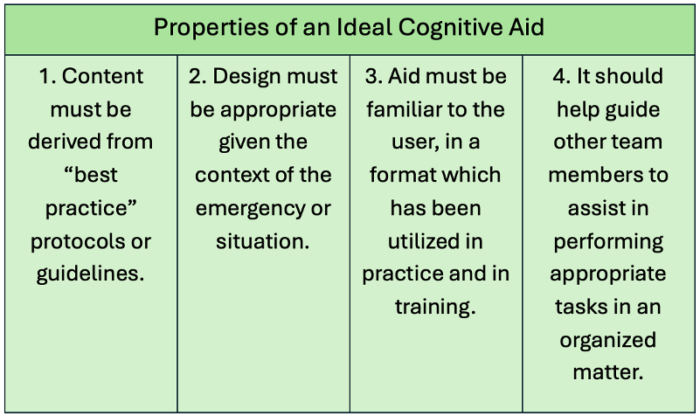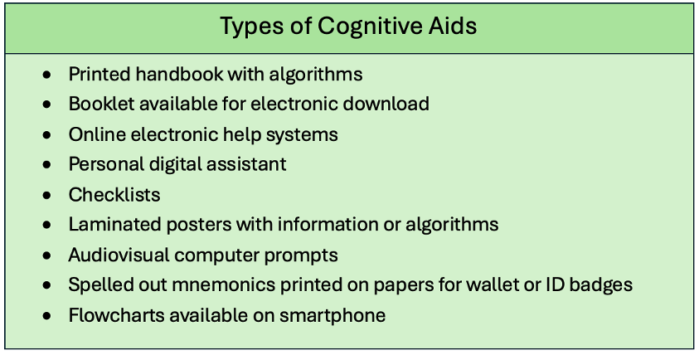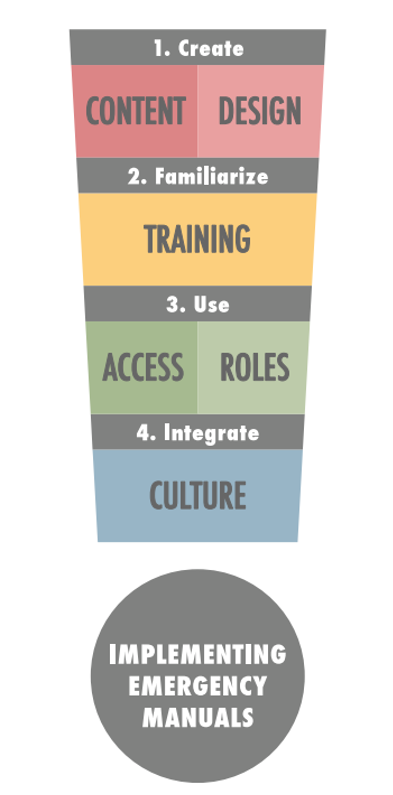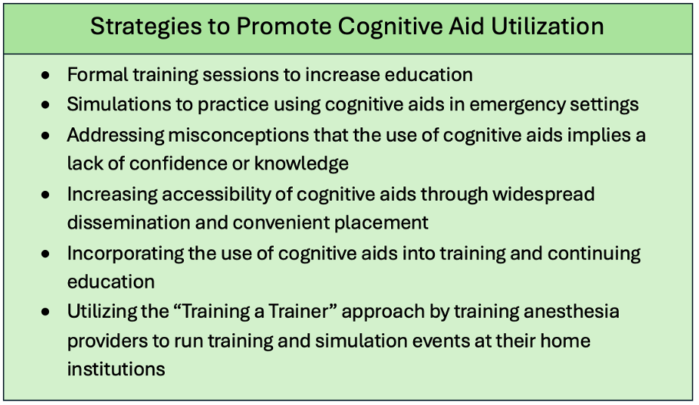Copy link
Cognitive Aids
Last updated: 03/29/2024
Key Points
- Cognitive aids are tools derived from best practice protocols that should be utilized easily to navigate during crisis management, enhance patient safety, and reduce omissions of critical steps during stressful situations.
- Cognitive aids have shown benefit in the management of a range of anesthetic crises.
- Strategies to help increase the utilization of cognitive aids may include formal training sessions and simulations to increase education and familiarity, as well as increasing accessibility through widespread dissemination and convenient placement.
Introduction
- Cognitive aids are tools which guide users while performing tasks to help reduce errors or omissions, while increasing performance speed and fluidity.1
- These were used first in aviation to create standardized procedures to ensure safe flying but have since been commonly implemented in the healthcare setting for a variety of uses.
- Unlike standard operating procedures or protocol, cognitive aids are to be used while a task is being performed. Unlike many extensive and detailed documents or sources, cognitive aids should be easy to follow, navigate, and utilize during an emergency. These tools can be particularly useful during rare, emergent events.1
- During a crisis, time and cognitive resources may become limited, and clinicians are more likely to forget memorized lists and become fixated.1
- Therefore, a cognitive aid should guide clinicians through a sequence of steps, preventing the omission of key items or actions.
- Cognitive aids should also be efficient – tailored for the specific situation and without unnecessary or irrelevant measures.
- The properties of ideal cognitive aids are demonstrated in Table 1.1

Table 1. Properties of an ideal cognitive aid
Types of Aids
- The design of cognitive aids must be appropriate given the emergency or situation that necessitates its use.
- A design that is familiar to the user, easy to understand, and easily accessible encourages the use of cognitive aids during emergencies.
- Table 2 lists the different types of cognitive aids that have been used in the anesthetic management of patients.1
- Table 3 lists cognitive aids that are commonly used in anesthesia, as well as their online download links.

Table 2: Types of cognitive aids
Commonly Used Cognitive Aids and Sources
- Operating Room Emergency Manuals, Stanford University
- Operating Room Crisis Checklist, Harvard University
- OB Emergency Manuals, Stanford University
- Pedi Crisis, Society for Pediatric Anesthesia
- The Thoracic Crisis Manuals, Canadian Thoracic Taskforce
- Neuroanesthesia Crisis manuals, Society for Neuroscience in Anesthesiology and Critical Care (SNACC)
- The Cognitive Aids for the Management of Deteriorating Surgical Patients (CAMDS), Amsterdam University Medical Centers (AUMC)
- The Quick Reference Handbook (QRH), Association of Anesthetists of Great Britain & Ireland (AAGBI)
Table 3. Common cognitive aids used by anesthesia providers in perioperative emergencies
- Once the properties of an ideal cognitive aid, as well as effective design has been considered, and a cognitive aid is created, there are still steps required for effective implementation of these aids in anesthetic practice.
- Familiarity with cognitive aids must be gained through effective training sessions, which may include institutional simulation activities to practice using these aids in emergency settings.
- Further, use of these aids in emergency settings can be supported by making these aids easily accessible, and having determined roles regarding who will be utilizing the aid, and what supporting team members can do in these situations.
- These aids should also be supported by the institution’s quality and safety culture.
- The framework for successful implementation of cognitive aids is summarized in Figure 1.2

Figure 1. Steps for successful implementation of cognitive aids. Source: Goldhaber-Fiebert SN, et al. Emergency manual uses during actual critical events and changes in safety culture from the perspective of anesthesia residents: A pilot study. Anesth Analg. 2016. Used with permission from Dr. Goldhaber-Fiebert.
Outcomes
- The benefits of the use of cognitive aids by anesthesia providers in the perioperative setting have been well studied.
- A Stanford study of emergency manual use during critical events in anesthesia found that fifteen months after the implementation of emergency manuals in the clinical setting, 45% of respondents had used an emergency during an actual critical event, and 80% of these individuals agreed or strongly agreed that the tool resulted in better care delivered by the team to the patient.2 The other 20% were neutral towards the use of emergency manuals during critical events.2
- A multi-institutional study in China found that greater than 70% of all respondents reported using an emergency manual during at least one critical event within the 6 months following nationwide implementation.3
- Cognitive aids have been shown to decrease the number of omitted critical steps during emergency management and increase the speed of crisis management while decreasing the number of failed intervention attempts. Numerous reports of emergency manuals in the clinical setting have demonstrated improved patient outcomes with the use of these tools.4
- It is important to note that while cognitive aids may improve task completion, their effects on team communication is not always clear.1 Having a designated reader who is primarily using the cognitive aid may result in decreased communication or contribution by other members of the team.1 Ensuring that communication and contribution between all members of the team remains open, efficient, and targeted during crisis management.
Recommendations
- While the widespread creation and implementation of cognitive aids has showed early benefit in the perioperative setting for anesthesia providers, some recommendations to improve the development, testing, and acceptance of cognitive aids have been suggested.
- Although the benefits of cognitive aids have been studied, there are still instances where cognitive aids fail, and future studies need to identify when and why cognitive aids are unsuccessful in crisis management.
- Some studies have suggested that even in clinical settings where cognitive aids are well-designed and readily available, there is a low incidence of use during emergencies.1 Future studied should aim to understand why cognitive aids are not being more commonly utilized in the clinical setting, and how these barriers can be overcome.
- Strategies to help increase the utilization of cognitive aids are presented in Table 4.1,5

Table 4. Strategies to promote cognitive aid utilization in the clinical setting1,5
References
- Marshall S. The use of cognitive aids during emergencies in anesthesia: a review of the literature. Anesth Analg. 2013; 117(5):1162-71. PubMed
- Goldhaber-Fiebert SN, Pollock J, Howard SK, et al. Emergency manual uses during actual critical events and changes in safety culture from the perspective of anesthesia residents: A pilot study. Anesth Analg. 2016; 123(3):641-9. PubMed
- Huang J, Wu J, Dai C, Zhang X, Ju H, Chen Y, Zhang C, Ye F, Tan Y, Zong Y, Liu T. Use of emergency manuals during actual critical events in China: A multi-institutional study. Simul Healthc. 2018; 13(4):253-260. PubMed
- Simmons WR, Huang J. Operating room emergency manuals improve patient safety: A systemic review. Cureus. 2019; 11(6):e4888. PubMed
- Irvine D, Huang J. International experience and outcomes of OR emergency manual implementation. ASA Monitor. 2023; 87(5): 35-36. Link
Other References
- Morelli RC, Cooper JB. APSF Sponsors Workshop on Implementing Emergency Manuals. Anesthesia Patient Safety Foundation Newsletter. 2016; 30(3). Link
Copyright Information

This work is licensed under a Creative Commons Attribution-NonCommercial-NoDerivatives 4.0 International License.